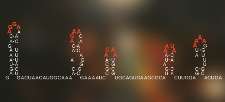A code hidden in the arrangement of the genetic information of single-stranded RNA viruses instructs the virus how to pack itself within its outer shell of proteins. Credit: University of Leeds
Researchers, including Dr Robert Coutts, Research Fellow from the School of Life and Medical Sciences, University of Hertfordshire, have cracked a code that governs infections caused by simple, single-stranded RNA viruses similar in many respects to viruses that cause the common cold, polio and the winter vomiting norovirus infections.
Until now, scientists had not noticed the code, which had been hidden in plain sight in the sequence of the ribonucleic acid (RNA) that makes up this type of viral genome.
The molecular details of how these viruses self-assemble protective protein containers around their cognate genomes in a specific and efficient manner have been revealed and illustrate multiple contacts between coat proteins and dispersed packaging signals in the viral genome.
Professor Peter Stockley, who led the Biotechnology and Biological Sciences Research Council (BBSRC) funded investigation at the Astbury Centre for Structural Molecular Biology, University of Leeds said: "If you think of this as molecular warfare, these are the encrypted signals that allow a virus to deploy itself effectively. Now, for this whole class of viruses, we have found the 'Enigma machine' - the coding system that was hiding these signals from us. We have shown that not only can we read these messages but we can jam them and stop the virus' deployment."
The next step will be to widen the study into animal viruses. The researchers believe that their combination of single-molecule fluorescence spectroscopy detection and their computational models offers a novel route for drug discovery.
Further funding to explore these aspects has been secured from the BBSRC in a new three-year investigation entitled ''Testing novel anti-viral strategies in plants''.
More information: N. Patel et al. 'Revealing the density of encoded functions in a viral RNA'' is published online at Proceedings of the National Academy of Sciences (PNAS) www.pnas.org/content/112/7/2227.abstract
Journal information: Proceedings of the National Academy of Sciences
Provided by University of Hertfordshire





















